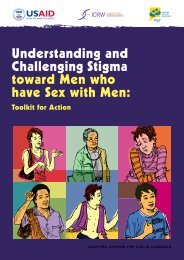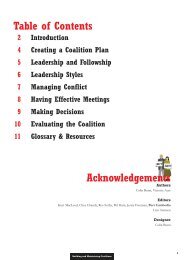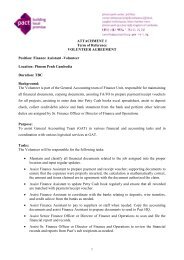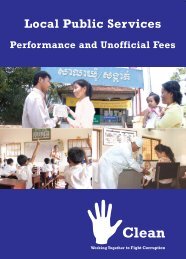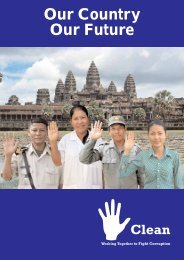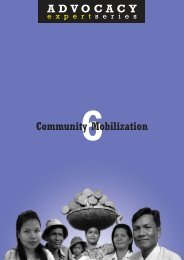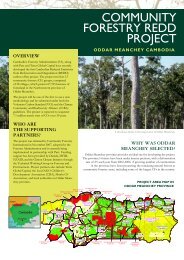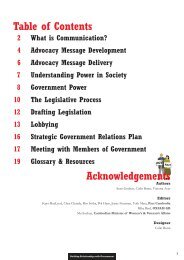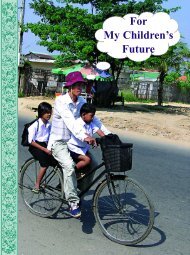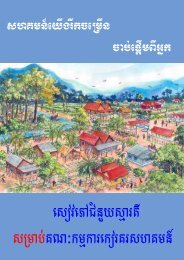Advocacy in Cambodia: Increasing Democratic ... - Pact Cambodia
Advocacy in Cambodia: Increasing Democratic ... - Pact Cambodia
Advocacy in Cambodia: Increasing Democratic ... - Pact Cambodia
Create successful ePaper yourself
Turn your PDF publications into a flip-book with our unique Google optimized e-Paper software.
Case Studies<br />
two of the more <strong>in</strong>dependent unions.<br />
Cooperation and International Network<strong>in</strong>g<br />
While cooperation between unions appears<br />
weak, <strong>in</strong>ternational agencies work <strong>in</strong> close<br />
coord<strong>in</strong>ation with them, often conduct<strong>in</strong>g jo<strong>in</strong>t<br />
tra<strong>in</strong><strong>in</strong>g activities. A number of <strong>in</strong>ternational trade<br />
unions have contact with <strong>Cambodia</strong>n unions,<br />
<strong>in</strong>clud<strong>in</strong>g: the International Trade Union<br />
Secretariat, the World Confederation of Labor,<br />
and <strong>in</strong>ternational woodworkers, textile, leather,<br />
and <strong>in</strong>dustrial unions.<br />
Lessons Learned<br />
• Most of the progress made <strong>in</strong> the<br />
<strong>Cambodia</strong>n labor movement is due to the<br />
<strong>in</strong>fluence of U.S. quotas and unfortunately not due<br />
to political will to improve <strong>Cambodia</strong>n garment<br />
workers’ conditions.<br />
• The ma<strong>in</strong> need of the garment labor<br />
movement, like other sectors covered <strong>in</strong> this<br />
report, is to develop strong leaders who know how<br />
to barga<strong>in</strong>. Until union leaders ga<strong>in</strong> the strength<br />
to conduct collective barga<strong>in</strong><strong>in</strong>g with employers,<br />
concessions won are likely to rema<strong>in</strong> limited.<br />
• Many <strong>in</strong>ternational agencies would like to<br />
support unions, but they do not usually<br />
understand how unions work. In order for the<br />
<strong>Cambodia</strong>n labor movement to become strong, it<br />
must be developed slowly and unions need to<br />
widen their outreach to non-labor sector<br />
<strong>in</strong>ternational agencies.<br />
• While unions tend not to cooperate with<br />
each other, companies are very united and present<br />
a solid front to the unions. If unions are to<br />
cont<strong>in</strong>ue to ga<strong>in</strong> <strong>in</strong> strength, they need to present<br />
a similar united front to government and<br />
employers.<br />
• Union leaders <strong>in</strong>dicate that study tours, <strong>in</strong><br />
which they are able to meet and exchange ideas<br />
with other union leaders, are particularly useful<br />
to them. In one example, union leaders were<br />
particularly impressed by meet<strong>in</strong>gs with leaders<br />
of Native American communities that were<br />
fight<strong>in</strong>g for their rights.<br />
Future Considerations<br />
Long-Term Plann<strong>in</strong>g<br />
In 2005, WTO regulations require that U.S.<br />
quotas be phased out. While a number of scenarios<br />
are imag<strong>in</strong>ed - factories lay<strong>in</strong>g off workers and<br />
companies mov<strong>in</strong>g to Ch<strong>in</strong>a; downward pressure<br />
be<strong>in</strong>g applied to wages - none of the central actors<br />
appears to be develop<strong>in</strong>g (<strong>in</strong>dividually or <strong>in</strong><br />
collaboration) a plan to reta<strong>in</strong> <strong>in</strong>vestors <strong>in</strong><br />
<strong>Cambodia</strong>.<br />
One possibility should be to improve work<strong>in</strong>g<br />
conditions <strong>in</strong> <strong>Cambodia</strong>’s garment factories to the<br />
extent that buyers feel justified <strong>in</strong> pay<strong>in</strong>g slightly<br />
more for <strong>Cambodia</strong>n products as they are help<strong>in</strong>g<br />
to protect human rights. This would require first<br />
improv<strong>in</strong>g work<strong>in</strong>g conditions <strong>in</strong> factories so that<br />
they meet legal requirements and then organiz<strong>in</strong>g<br />
a campaign target<strong>in</strong>g overseas buyers, particularly<br />
from the U.S. and Europe. So far, promotion of<br />
<strong>Cambodia</strong>n goods has been limited or nonexistent,<br />
although the ILO monitor<strong>in</strong>g synthesis<br />
report did appeal to U.S. buyers to become<br />
<strong>in</strong>terested <strong>in</strong> <strong>Cambodia</strong>n production. In order for<br />
such a campaign to reach buyers <strong>in</strong> time, it would<br />
have to be organized fairly soon, as only three<br />
years of the quota system rema<strong>in</strong>.<br />
Export Process<strong>in</strong>g Zone<br />
The government is currently work<strong>in</strong>g on<br />
legislation to create Export Process<strong>in</strong>g Zones<br />
(EPZ) on the Thai border that would allow Thai<br />
<strong>in</strong>frastructure to be comb<strong>in</strong>ed with low-skilled<br />
<strong>Cambodia</strong>n assembly labor, along the l<strong>in</strong>es of the<br />
maquiladora process<strong>in</strong>g plants on the U.S.-Mexico<br />
border. The draft law is not explicit regard<strong>in</strong>g the<br />
presence of unions <strong>in</strong> these zones, and union<br />
leaders fear that the EPZs would be used to<br />
circumvent the Labor Law, especially s<strong>in</strong>ce an ILO<br />
convention suggests exceptions for develop<strong>in</strong>g<br />
countries. Five unions are currently study<strong>in</strong>g the<br />
issue and learn<strong>in</strong>g from examples <strong>in</strong> countries like<br />
the Philipp<strong>in</strong>es. While it is good to have<br />
<strong>in</strong>vestment <strong>in</strong> the country, unions and union<br />
supporters feel that <strong>in</strong>vestors must allow<br />
organized labor to operate <strong>in</strong> those zones and will<br />
accord<strong>in</strong>gly lobby for this to occur.<br />
References<br />
Barton, Michael, 2000. The Labor Movement <strong>in</strong> <strong>Cambodia</strong>: A Short<br />
History. Civil Society and Good Governance. <strong>Cambodia</strong>n Institute<br />
for Cooperation and Peace. Volume 1, Issue 1.<br />
Engquist, Michael, 2001. Mak<strong>in</strong>g Garments Worth Produc<strong>in</strong>g: A<br />
Survey of the Trade Union Movement With<strong>in</strong> the <strong>Cambodia</strong>n<br />
Garment Industry. Star Kampuchea, Phnom Penh, <strong>Cambodia</strong>.<br />
Connor, Tim, 2001. Still Wait<strong>in</strong>g for Nike to Do It: Nike’s Labor<br />
Practices <strong>in</strong> the Three Years S<strong>in</strong>ce CEO Phil Knight’s Speech to the<br />
National Press Club. Global Exchange, San Francisco, California,<br />
USA.<br />
International Labor Organization, 2001. First Synthesis Report on<br />
Work<strong>in</strong>g Conditions <strong>in</strong> <strong>Cambodia</strong>’s Garment Sector.<br />
Footnotes<br />
1<br />
There are a number of non-garment unions <strong>in</strong> <strong>Cambodia</strong>, <strong>in</strong>clud<strong>in</strong>g:<br />
teachers, construction and restoration of Angkor Wat workers,<br />
commercial sex workers, tourism, Naga Cas<strong>in</strong>o, hotel workers <strong>in</strong><br />
Phnom Penh and Siem Reap, shoe makers, and wood forest workers<br />
(rubber <strong>in</strong>cluded).<br />
2<br />
The first trade union <strong>in</strong> post-war <strong>Cambodia</strong> was actually established<br />
<strong>in</strong> 1979, but was considered a tool for the socialist government to<br />
implement government policies.<br />
3<br />
Worker representative elected by employees who are not<br />
represented by a union.<br />
66




